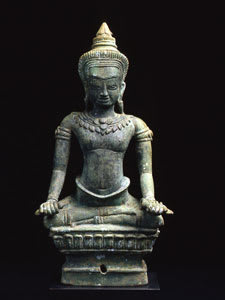Khmer Sculpture of the Buddha Vajrasattva, 12th Century CE - 13th Century CE
Bronze
height 21 cm
height 8 1/4 in
height 8 1/4 in
FZ.415
The Khmer civilization, today embodied by the temple and ruins of Angkor, flourished from 802-1431 A.D. From the great citadel of Angkor, one of mankind' most astonishing and enduring architectura...
The Khmer civilization, today embodied by the temple and ruins of Angkor, flourished from 802-1431 A.D.
From the great citadel of Angkor, one of mankind' most astonishing and enduring architectura achievements, the kings of the Khmer empire ruled ove a vast domain that reached from what is now souther Vietnam to Yunnan, China and from Vietnam westward t the Bay of Bengal. The original city was built aroun the Phnom Bakeng, a temple on a hill symbolizing th mountain that stands in the center of the worl according to Hindu cosmology. Successive king enlarged the city, building other temples devoted t various Hindu deities and large reservoirs used fo irrigation, which also symbolized the ocea surrounding the holy central mountain.
Architecture reached its peak during the Angkor Wa style, certainly best revealed in the grand Visnuit temple after which this style is named. However,
during this period of architectural innovation,
sculpture instead aesthetically returned back to a earlier era, specifically the first half of the 10t century. The sculptural archaism of this period ma have been influenced by the politics. Thus, th renewed grandeur of Angkor Wat sculpture reflected th power of the king. It is also possible that sculptor looked longingly back at the motifs and styles o previous periods that had fallen into disuse.
The historical figure, Buddha Gautama Sakyamuni is th Buddha of compassion who, having achieved the highes evolutionary perfection, turns suffering int happiness for all living beings. Born around 560 B.C.
somewhere between the hills of south Nepal and th Rapti river, his father was a Raja who ruled over th northeastern province of India, the district includin the holy Ganges River. The young prince was married t Yashoda when he was about 17 years old and togethe they had a son named Rahula. At the age of 29, he lef his life of luxury, as he felt compelled to purify hi body and make it an instrument of the mind by riddin himself of earthly impulses and temptations.
This sculpture depicts the Buddha Vajrasattva, th Buddha of Purification. In this form, the Adi Buddh is the manifestation of the energy of all the Buddhas,
thus reflecting the influence of monotheism on thi ancient religion. He is depicted seated in th Vajraparyanka posture holding the two attribute characteristic of this form, the vajra, o thunderbolt, in his right hand and the ghanta, o bell, in his left. He wears his hair in a hig conical bun, the form of which is highly suggestive o a lotus blossom. A diadem encircles his bun an frames his forehead. Jewerly adorns his ears, arms,
and neck, reflecting his royal origins. Th sophisticated artistry of the work suggests that i would have been placed in an important temple o palace, where reverant followers whould have onc payed their respects to the Buddha.
From the great citadel of Angkor, one of mankind' most astonishing and enduring architectura achievements, the kings of the Khmer empire ruled ove a vast domain that reached from what is now souther Vietnam to Yunnan, China and from Vietnam westward t the Bay of Bengal. The original city was built aroun the Phnom Bakeng, a temple on a hill symbolizing th mountain that stands in the center of the worl according to Hindu cosmology. Successive king enlarged the city, building other temples devoted t various Hindu deities and large reservoirs used fo irrigation, which also symbolized the ocea surrounding the holy central mountain.
Architecture reached its peak during the Angkor Wa style, certainly best revealed in the grand Visnuit temple after which this style is named. However,
during this period of architectural innovation,
sculpture instead aesthetically returned back to a earlier era, specifically the first half of the 10t century. The sculptural archaism of this period ma have been influenced by the politics. Thus, th renewed grandeur of Angkor Wat sculpture reflected th power of the king. It is also possible that sculptor looked longingly back at the motifs and styles o previous periods that had fallen into disuse.
The historical figure, Buddha Gautama Sakyamuni is th Buddha of compassion who, having achieved the highes evolutionary perfection, turns suffering int happiness for all living beings. Born around 560 B.C.
somewhere between the hills of south Nepal and th Rapti river, his father was a Raja who ruled over th northeastern province of India, the district includin the holy Ganges River. The young prince was married t Yashoda when he was about 17 years old and togethe they had a son named Rahula. At the age of 29, he lef his life of luxury, as he felt compelled to purify hi body and make it an instrument of the mind by riddin himself of earthly impulses and temptations.
This sculpture depicts the Buddha Vajrasattva, th Buddha of Purification. In this form, the Adi Buddh is the manifestation of the energy of all the Buddhas,
thus reflecting the influence of monotheism on thi ancient religion. He is depicted seated in th Vajraparyanka posture holding the two attribute characteristic of this form, the vajra, o thunderbolt, in his right hand and the ghanta, o bell, in his left. He wears his hair in a hig conical bun, the form of which is highly suggestive o a lotus blossom. A diadem encircles his bun an frames his forehead. Jewerly adorns his ears, arms,
and neck, reflecting his royal origins. Th sophisticated artistry of the work suggests that i would have been placed in an important temple o palace, where reverant followers whould have onc payed their respects to the Buddha.
